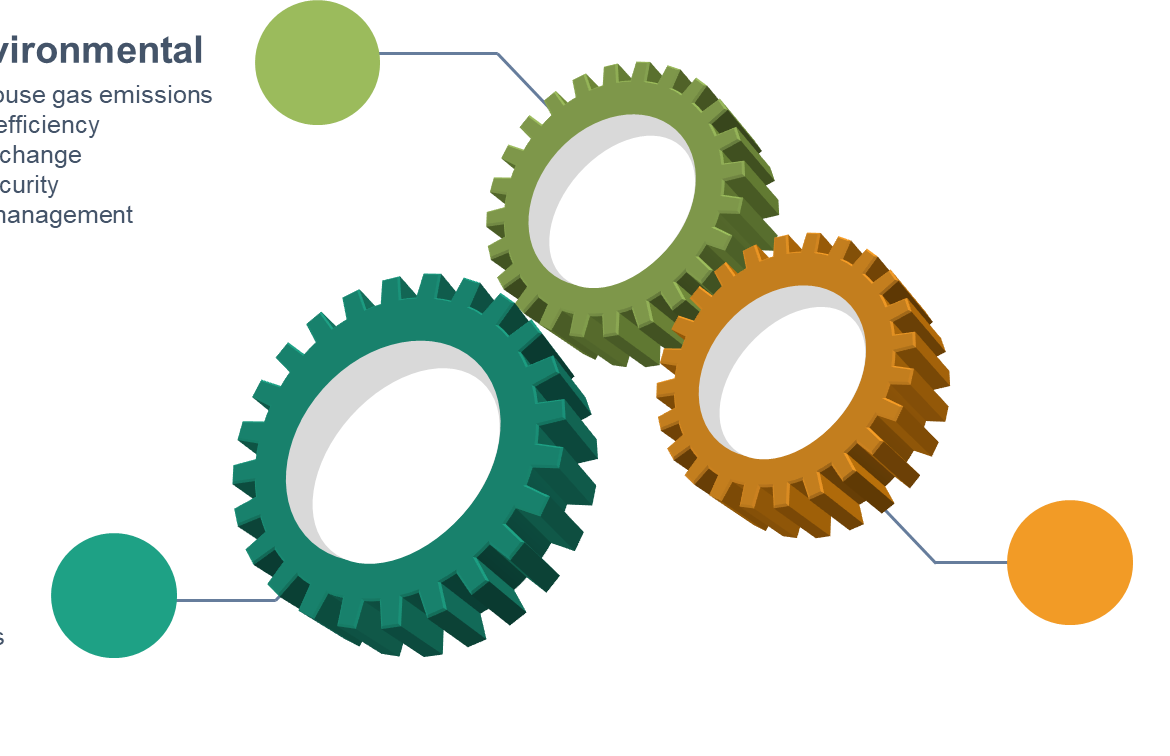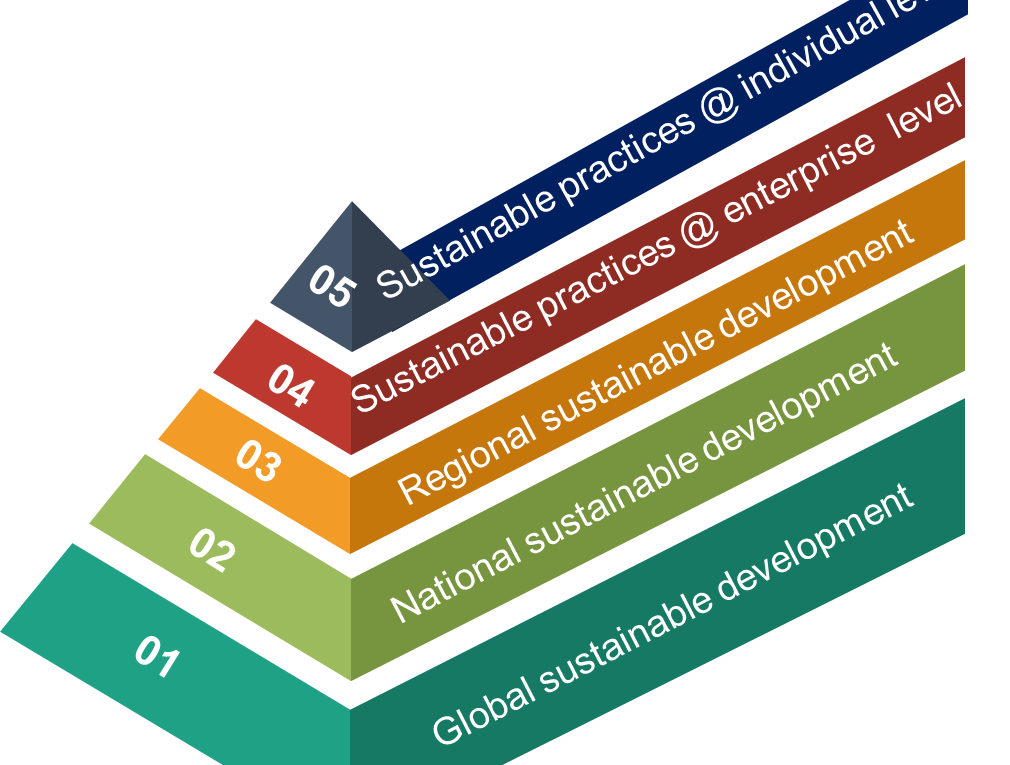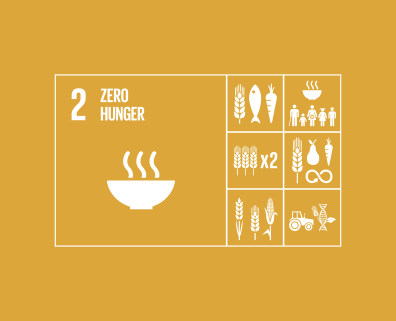
The term “better future” evokes the thoughts of progress, prosperity and success in our minds. We dream of a future loaded with modern technology and advanced gadgets making our lives easier and much more comfortable. But sadly, the same term “better future” simply means “availability of food” for millions of People, around the world. What seems to be just a temporary feeling for us, is a perpetual plight for people living with hunger. More than 800 million people worldwide are facing extreme hunger, which means they have minimum access to food. Hunger leads to malnutrition, which causes various deficiency diseases and even deaths. Undernutrition in responsible for 45% of deaths among children under 5. It affects both physical and mental health of people and is therefore a threat to the society. Along with adequate food supply, it is also important to provide proper nutrition to people, to ensure good health and well-being.
At individual level, unavailability of food is associated with poverty, but at Global level, food insecurity is far more complex. Nations where a large portion of population is undernourished, suffer slower economic growth and retarded development rate. Hunger is a major obstacle in the path of sustainable development and needs urgent action globally. End hunger, achieve food security and improved nutrition and promote sustainable agriculture.
SDG2
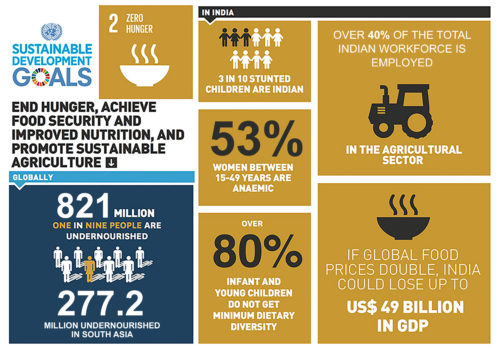
SDG2 “Zero Hunger” was drafted by the UN in 2015 with an aim to eradicate hunger, achieve food security, improve nutrition and promote sustainable agriculture by 2030. Like SDG1, SDG2 also seems to be unachievable as hunger has been on a rise since 2015. COVID-19 Pandemic has worsened the situation pushing nearly 100 million more people into hunger. Immediate actions must be taken to stop further rise in number of people facing extreme poverty.
SDG 2 Targets
2.1 By 2030, end hunger and ensure access by all people, in particular the poor and people in vulnerable situations, including infants, to safe, nutritious and sufficient food all year round.
2.2 By 2030, end all forms of malnutrition, including achieving, by 2025, the internationally agreed targets on stunting and wasting in children under 5 years of age, and address the nutritional needs of adolescent girls, pregnant and lactating women and older persons.
2.3 By 2030, double the agricultural productivity and incomes of small-scale food producers, in particular women, indigenous peoples, family farmers, pastoralists and fishers, including through secure and equal access to land, other productive resources and inputs, knowledge, financial services, markets and opportunities for value addition and non-farm employment.
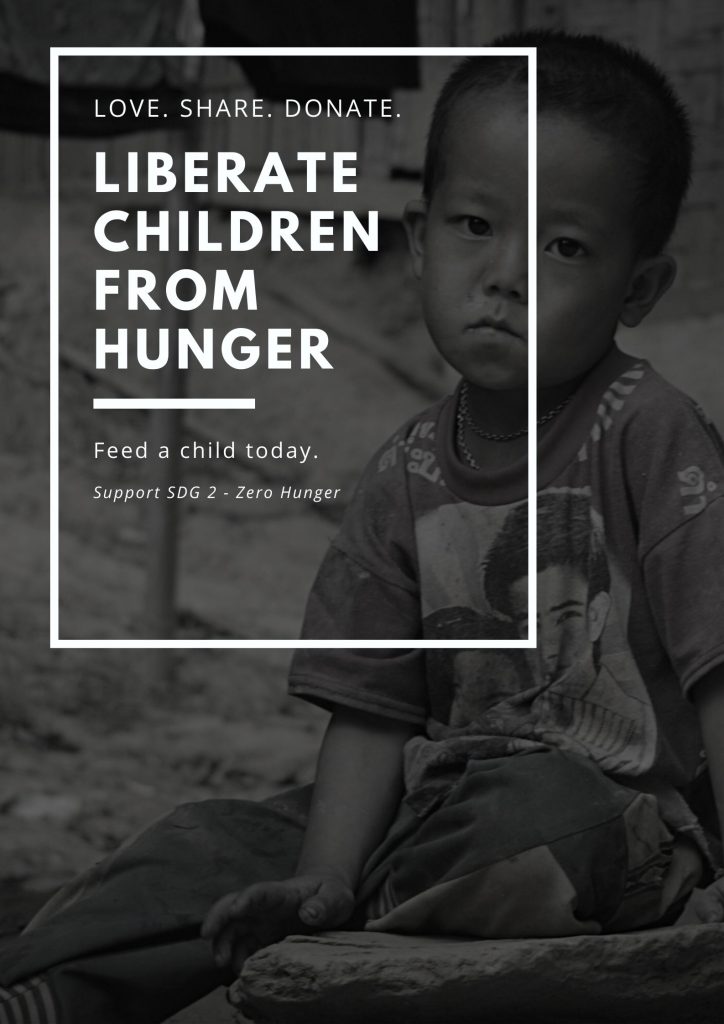
2.4 By 2030, ensure sustainable food production systems and implement resilient agricultural practices that increase productivity and production, that help maintain ecosystems, that strengthen capacity for adaptation to climate change, extreme weather, drought, flooding and other disasters and that progressively improve land and soil quality.
2.5 By 2020, maintain the genetic diversity of seeds, cultivated plants and farmed and domesticated animals and their related wild species, including through soundly managed and diversified seed and plant banks at the national, regional and international levels, and promote access to and fair and equitable sharing of benefits arising from the utilization of genetic resources and associated traditional knowledge, as internationally agreed.
2.A Increase investment, including through enhanced international cooperation, in rural infrastructure, agricultural research and extension services, technology development and plant and livestock gene banks in order to enhance agricultural productive capacity in developing countries, in particular least developed countries.
2.B Correct and prevent trade restrictions and distortions in world agricultural markets, including through the parallel elimination of all forms of agricultural export subsidies and all export measures with equivalent effect, in accordance with the mandate of the Doha Development Round.
2.C Adopt measures to ensure the proper functioning of food commodity markets and their derivatives and facilitate timely access to market information, including on food reserves, in order to help limit extreme food price volatility.
How can business contribute to SDG2
SDG2 is one of the the least prioritized SDGs for alignment with business, as it is not considered profitable and adds risks to business. Understanding the root cause of rising food insecurity, would give a better idea to the business community to contribute towards hunger eradication.
Factors affecting food security:
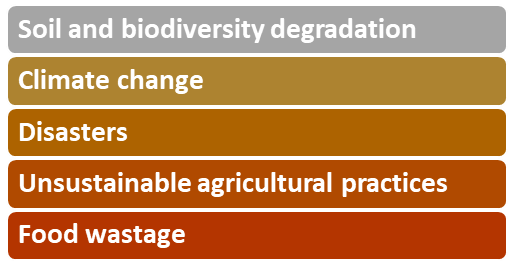
All these factors are responsible for food insecurity as they affect food production and supply chains, causing rise in food prices, and making it inaccessible for millions of people. Factors like Climate change and environmental degradation are also affecting the quality of food produced; scientists have been observing reduction in nutrient content of some crops in different parts of the world. Addressing to one or more of these issues would
Some sectors can directly align SDG2 with their business strategies and others may prioritize the SDGs that are linked with SDG2 and indirectly contribute towards eradicating hunger.
Sectors which can adopt SDG2:
Agriculture
Agriculture sector has a huge responsibility of feeding the ever growing world population, while facing the challenges posed by climate change, environmental degradation and natural disasters. To ensure food security, world food systems need to be more resilient. This can be achieved only by following sustainable practices through the entire supply chain and value chain of food production and processing. Sustainable agriculture increases profitability by reducing risks and increasing productivity. It also helps in restoring bio diversity of the region. Sustainably grown food products are also gaining popularity amongst consumers, due to growing awareness
Food retail
Food retailers can contribute to SDG2 by encouraging sustainable practices and minimizing food wastage through their entire supply chain. They must ensure that their products are sourced from farmers following sustainable agriculture practices. Large amounts of food products get wasted due to improper storage practices; retailers must ensure that food products are stored properly before and after reaching retail outlets. In case of disasters, food retailors can collaborate with local organizations, to identify vulnerable people and distribute perishable, non-perishable and surplus products among the deprived, thus avoiding wastage while fighting hunger.
Hospitality sector
Like food retailers, hospitality sector too can contribute towards SDG2 by encouraging sustainable food production practices and avoiding food wastage throughout their supply chains. Tourism can also encourage sustainable agriculture by promoting local knowledge and skills for developing farms and plantation sites as tourist attractions.
Other ways of contributing to SDG 2
- By adopting SDG 12 – Responsible consumption and production, and SDG 13- Climate action, companies are indirectly supporting SDG2.
- Companies can also implement sdg2 by promoting good nutrition among their employees and labor force.
- Food waste management at individual and organizational level would help in fighting hunger.
Business opportunities in SDG2
Biofertilizers
With growing consciousness, the demand of organic farming has been on a rise. Biofertilizers are now being preferred over chemical fertilizers. These fertilizers consist of microorganisms which improve soil fertility and provide nutrients to crops. The production of biofertilizers can turn out to be a profitable sustainable business idea, as it requires low investment, is environment friendly, and the raw materials are easily available. Bio fertilizers are produced from organic waste which can be obtained from livestock farms, food markets and food processing companies, by forming an alliance for waste management. Bio fertilizer production can also provide employment to underprivileged people.
Natural food coatings
Studies reveal that nearly one third of food produced globally for human consumption gets wasted each year, while millions have no access to food. This wastage can be minimized by increasing the shelf life of food products and prevent spoilage through their supply chain. This can be done in many ways, and many companies are coming up with innovative sustainable solutions for this. One such innovative solution is applying natural food coatings on fruits and vegetables. Natural coatings have proved to increase the shelf life of food products by weeks, while maintaining their natural taste and freshness. Since theses coatings are plant based, they are completely safe to human health and the environment. Producing such coatings would create a great business opportunity in SDG2.
Seaweed farming
Despite worldwide efforts, the problem of hunger has been growing, and agriculture alone can not tackle world hunger. Oceans are the second major food providers in the form of seafood, but unsustainable fishing is a big threat to the environment. Oceans are also home to Seaweed, which is being considered the food of the future. Certain varieties of Seaweed are safe for human consumption are loaded with nutrients. They are already being eaten in some countries and are also being processed into dietary supplements. Only 35 countries are producing Seaweed commercially and are generating good returns. Many more companies are working on improving the taste and appearance of Seafood to increase its popularity. Seaweed grow easily and quickly and can be harvested within weeks. Apart from being a profitable business idea, Seaweed farming has multiple environmental benefits like high carbon absorption and providing nesting ground for other sea creatures.
We might not achieve SDG 2 by 2030, but hunger can be reduced to a great extent through rigorous efforts by governments, business community and civil society.
